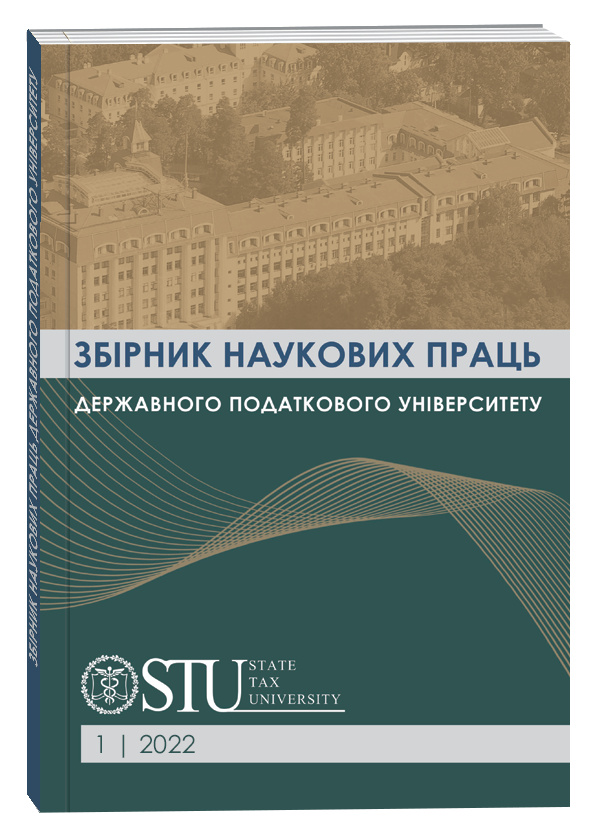THE TAX BURDEN ON THE UKRAINIAN ECONOMY: FORMATION, ASSESSMENT AND FORECASTING
DOI:
https://doi.org/10.33244/2617-5940.1.2022.35-56Keywords:
tax burden, taxation, unified social tax, national economyAbstract
The tax burden on the economy is an indicator of the efficiency of the tax system in the context of income redistribution in the national economy. The aim of the study is to improve the assessment and forecasting of the tax burden on the national economy of Ukraine. The main research methods are analysis and synthesis, comparative analysis, scientific abstraction, regression analysis, extrapolation and trend analysis, scenario analysis, and the graphical method. A methodology for assessing the tax burden on the national economy is proposed. A simulation of the dependence of consolidated budget tax revenues (direct relationship by linear function) and unified social contribution (direct relationship by power function) on the impact of GDP dynamics at actual prices was carried out. Pessimistic, realistic and optimistic scenarios for the tax burden on the Ukrainian economy have been developed. It has been shown that by the end of 2020 one-third of the revenues of Ukraine’s national economy are redistributed through the fiscal system, whereas in 2004 the tax burden was only one-fourth of GDP. It is established that the total tax burden on the national economy will remain at 2020 levels over the next 5 years (+0.2 %, depending on the projection scenario).
References
Ціна держави / Офіційний сайт CASE Ukraine. URL: https://cost.ua/ (дата звернення: 30.12.2021).
Konôpková Z. What is the real tax burden in Slovakia? Proceedings of the International scientific conference Hradec Economic Days 2021. DOI: http://dx.doi.org/10.36689/uhk/hed/2021-01-034
Martynenko V. V. Assessment of favorableness for the tax system of Ukraine in the international context. Baltic Journal of Economic Studies. 2019. Vol. 5. № 2. Р. 124–130. DOI: http://dx.doi.org/10.30525/2256-0742/2019-5-2-124-130
Martynenko V. Estimation of the overall tax burden on the economy in Ukraine. EUREKA: Social and Humanities. 2019. № 4. Р. 23–29. DOI: http://dx.doi.org/10.21303/2504-5571.2019.00947
Мартиненко В. В. Прогнозний підхід до формування податкових надходжень місцевих бюджетів України в умовах децентралізації. Ефективна економіка. 2019. № 9. DOI: https://doi.org/10.32702/2307-2105-2019.9.45. URL: http://www.economy.nayka.com.ua/?op=1&z=7269 (дата звернення: 30.12.2021).
Мартиненко В. В. Сучасні тенденції розвитку та перспективи оподаткування в Україні. Бізнес Інформ. 2018. № 11. С. 414–420.
Moore, J. Weatherford, L. R. Decision Modeling with Microsoft® Excel. 6th Edition. N.J.: Prentice Hall PTR, 2001. XVI, 693 p.
Наконечний С. І., Терещенко Т. О., Романюк Т. П. Економетрія. Вид. 3-тє, доп. та переробл. К.: КНЕУ, 2004. 520 с.
Paying Taxes / офіційний сайт PricewaterhouseCoopers. URL: https://www.pwc.com/gx/en/services/tax/publications/paying-taxes-2020.html (дата звернення: 30.12.2021).
Rievajová E., Kovárová A., Přívara A. Measuring the income and payroll tax burden with emphasis on the effective marginal tax rate. Business and Economic Horizons. 2018. Vol. 14. № 5. P. 1011–1026. DOI: http://dx.doi.org/10.15208/beh.2018.69
Rudy K. V. Political tax cycles: Cyclicality of the tax burden in election periods. Journal of Tax Reform. 2021. Vol. 7. № 2. P. 193–205. DOI: https://doi.org/10.15826/jtr.2021.7.2.098
Spengel C., Li W., Zinn B., Finke K. The computation and comparison of the effective tax burden in four Asian countries. Hitotsubashi Journal of Economics. 2011. Vol. 52. № 1. P. 13–39. URL: http://www.jstor.org/stable/43296244 (дата звернення: 30.12.2021).
Індекси споживчих цін на товари та послуги у 2002–2021 роках (рік до попереднього року) / офіційний сайт Державної служби статистики України. URL: http://www.ukrstat.gov.ua/operativ/operativ2020/ct/isc_rik/isc2002-2020rik_pr.xls (дата звернення: 30.12.2021).
Валовий внутрішній продукт / Офіційний сайт Державної служби статистики України. URL: http://ukrstat.gov.ua/operativ/operativ2020/vvp/vvp_rik/arh_vvp_rik_90-18u.htm (дата звернення: 30.12.2021).
Tiwari A. K. Tax burden and GDP: Evidence from frequency Doman approach for the USA. Economics Bulletin. 2012. Vol. 32. № 1. P. 147–159.
Vatslavskyi O., Ivanova A. The impact of tax burden on economic activity of business entities under conditions of using information technology. 11th International Conference on Advanced Computer Information Technologies (ACIT). Deggendorf, 2021. P. 356–359. DOI: https://doi.org/10.1109/ACIT52158.2021.9548597
CASE Ukraine (2021). Tsina derzhavy [The price of the state]. URL: https://cost.ua/ (in Ukrainian).
Konôpková, Z. (2021). What is the real tax burden in Slovakia? Proceedings of the International scientific conference Hradec Economic Days 2021. DOI: http://dx.doi.org/10.36689/uhk/hed/2021-01-034
Martynenko, V. (2019a). Assessment of favourableness for the tax system of Ukraine in the international context. Baltic Journal of Economic Studies, 5(2), 124–130. DOI: https://doi.org/10.30525/2256-0742/2019-5-2-124-130.
Martynenko, V. (2019b). Estimation of the overall tax burden on the economy in Ukraine. EUREKA: Social and Humanities, (4), 23–29. DOI: https://doi.org/10.21303/2504-5571.2019.00947.
Martynenko, V. (2019). Prohnoznyi pidkhid do formuvannia podatkovykh nadkhodzhen mistsevykh biudzhetiv Ukrainy v umovakh detsentralizatsii [Predictive approach to the formation of tax revenues of Ukrainian local budgets in the context of decentralization]. Efektyvna ekonomika, (9). DOI: https://doi.org/10.32702/2307-2105-2019.9.45 (in Ukrainian).
Martynenko, V. V. (2018). Suchasni tendentsii rozvytku ta perspektyvy opodatkuvannia v Ukraini [The contemporary tendencies of development and the prospects of taxation in Ukraine]. Business Inform, (11), 414–420 (in Ukrainian).
Moore, J. & Weatherford, L. R. (2001). Decision Modeling with Microsoft® Excel. 6th Edition. NJ United States: Prentice Hall PTR.
Nakonechnyi, S. I., Tereshchenko, T. O., & Romaniuk, T. P. (2004). Ekonometriia [Econometrics]. 3d Edition. Kyiv Ukraine: KNEU (in Ukrainian)
PwC (2021). Paying Taxes. URL: https://www.pwc.com/gx/en/services/tax/publications/paying-taxes-2020.html
Rievajová, E., Kovárová, A., & Přívara, A. (2018). Measuring the income and payroll tax burden with emphasis on the effective marginal tax rate. Business and Economic Horizons, 14(5), 1011–1026. DOI: http://dx.doi.org/10.15208/beh.2018.69
Rudy, K. V. (2021). Political tax cycles: Cyclicality of the tax burden in election periods. Journal of Tax Reform, 7(2), 193–205. DOI: https://doi.org/10.15826/jtr.2021.7.2.098
Spengel, C., Li, W., Zinn, B., & Finke, K. (2011). The computation and comparison of the effective tax burden in four Asian countries, Hitotsubashi Journal of Economics. 52(1), 13–39. URL: http://www.jstor.org/stable/43296244
State Statistics Service of Ukraine (2021a). Indeksy spozhyvchykh tsin na tovary ta posluhy u 2002–2021 rokakh (rik do poperednoho roku) [Consumer price indices for goods and services in 2002–2021 (year to previous year)]. URL: http://www.ukrstat.gov.ua/operativ/operativ2020/ct/isc_rik/isc2002-2020rik_pr.xls (in Ukrainian).
State Statistics Service of Ukraine (2021). Valovyi vnutrishnii produkt [Gross domestic product]. URL: http://ukrstat.gov.ua/operativ/operativ2020/vvp/vvp_rik/arh_vvp_rik_90-18u.htm (in Ukrainian).
Tiwari, A. K. (2012). Tax burden and GDP: Evidence from frequency Doman approach for the USA. Economics Bulletin, 32(1), 147–159.
Vatslavskyi, O., & Ivanova, A. (2021). The impact of tax burden on economic activity of business entities under conditions of using information technology, 11th International Conference on Advanced Computer Information Technologies (ACIT), (pp. 356–359). DOI: https://doi.org/10.1109/ACIT52158.2021.9548597



